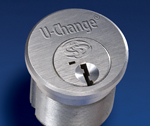Picture this scenario: you terminated an employee and, after multiple attempts, have been unable to get their keys back.
Undoubtedly, it’s not an ideal situation, but which rekey situation would you prefer?
- You call a technician to come out after-hours and pay emergency rates to have your locks changed. This is followed by late-night scrambling to get the key to tomorrow’s opener. Oh wait, it’s 8 o’clock – they aren’t answering their phone – of course.
- You head straight to your safe, pull out a rekey packet and turn a key in each lock – you then head home for dinner with the family. You can give tomorrow’s opener their new key before they leave for the day.
I don’t know about you, but the second scenario sounds a lot better to me. It’s not rocket science; rekeys really can be that easy with user-rekeyable cylinders on your key system.
What is a user rekeyable cylinder for a key system?
All cylinders are rekeyable, but there are a few on the market that are user-rekeyable. This means there is no need to call a technician or swap out a core – you can do it yourself. Easily.
The most popular user-rekeyable systems on the key system market are InstaKey and U-Change. There are a few differences to note between the two:
- InstaKey is available in both standard and interchangeable cylinders; whereas, U-Change is only available in standard cylinders.
- InstaKey simply uses a key to rekey the lock, compared to U-Change which uses a key and a key-change tool.
- Depending on your system setup, InstaKey cylinders can be rekeyed anywhere from 9 to 12 times* before replacing the cylinder. U-Change cores can be rekeyed indefinitely without replacing the cylinder.
How do user rekeyable cylinder systems work?
User-rekeyable systems use proprietary technology that changes the combination of pins in each lock chamber to match the next user key. Check out these videos to see how quick and easy it is to rekey a lock using InstaKey and U-Change.
The keys needed to change to the next user key level (or step) are shipped in a “next step packet.” Stores can either keep them in the safe for immediate usage, or they can have them overnighted for emergency rekeys. If they are kept in the safe, it’s important for the store to order a new next-step packet immediately upon using the old one so they will be ready for the next rekey.
What are the benefits of rekeyable cylinders?
As you can probably guess, the biggest benefit of user-rekeyable cylinders is the long-term cost savings gained by avoiding having a locksmith rekeying your locations. Check out this blog post that reviews the ROI of InstaKey.
Another big plus is the ability to immediately perform rekeys without waiting for a technician. If you are on a managed key system, you also won’t have to wait for cores to be shipped.
Are there any drawbacks to rekeyable cylinders?
The only drawback is the initial cost of installation. Naturally, on the key system spectrum, rekeyable cylinders are going to cost more at the onset; however, it’s easily worth it in the long run.
If you have any questions or want to learn more about the specifics of either system, email us or let us know in the comments section below. We’d be happy to answer any questions! Next week we’re moving on to discuss the ins and outs of master key systems – see you then!
*The number of times you can rekey depends on whether or not you are on a Master System (which we will talk about next week). You can rekey 9 times with no mastering. If you are on a Master System, you can rekey up to 12 times within a system, independent of other levels. For example, you can rekey 3 times on the Grand Master level, 5 times on the Sub Master, and 5 times on all doors under the Master.
Check out our Key Systems 101 article for more information.
[maxbutton id=”1″]
Check out the rest of our series:
The Five Critical Components of Key System Management
Key System Types: Restricted, Unrestricted, and Proprietary
Proprietary & Restricted Key Systems
Standard Cylinders versus Interchangeable Cylinders – What’s the Difference?
eCylinders – The Amazing, The Mundane, and The Considerations
Rekeyable Cylinders – Fast, Easy, & Cost Effective
Master Key Systems – Controlled Access With One Key
Key System Policies – Keep Your System In Tact
Key System Procedures – A Roadmap for Maintaining Your System’s Integrity
Rekey Policies & Procedures – Three Elements to Consider
Key System Records Management – 4 Cornerstones

10 thoughts on “Key Systems: Rekeyable Cylinders – Fast, Easy, & Cost Effective”